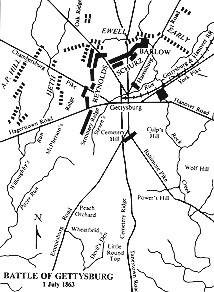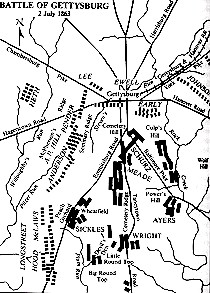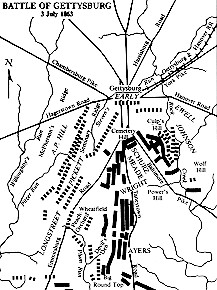![]()
Gen. Robert E. Lee concentrated his full strength against Maj. Gen. George G. Meade's Army of the Potomac at the crossroads county seat of Gettysburg. On July 01, Confederate forces converged on the town from west and north, driving Union defenders back through the streets to Cemetery Hill. During the night, reinforcements arrived for both sides. On July 2, Lee attempted to envelop the Federals, first striking the Union left flank at the Peach Orchard, Wheatfield, Devil's Den, and the Round Tops with Longstreet's and Hill's divisions, and then attacking the Union right at Culp's and East Cemetery Hills with Ewell's divisions.
By evening, the Federals retained Little Round Top and had repulsed most of Ewell's men. During the morning of July 3, the Confederate infantry were driven from their last toe-hold on Culp's Hill. In the afternoon, after a preliminary artillery bombardment, Lee attacked the Union center on Cemetery Ridge. The Pickett-Pettigrew assault (more popularly, Pickett's Charge) momentarily pierced the Union line but was driven back with severe casualties. Stuart's cavalry attempted to gain the Union rear but was repulsed. On July 4, Lee began withdrawing his army toward Williamsport on the Potomac River. His train of wounded stretched more than fourteen miles.
Result(s): Union victory
Location: Adams County
Campaign: Gettysburg Campaign (June-August 1863)
Date(s): July 1-3, 1863
Principal Commanders: Maj. Gen. George G. Meade [US]; Gen. Robert E. Lee [CS]
Forces Engaged: 158,300 total (US 83,289; CS 75,054)
Estimated Casualties: 51,000 total (US 23,000; CS 28,000)
Source:
![]()
In July of 1863, General Robert E. Lee's Army Of Northern Virginia of 75,000 men and the 97,000 man Union Army Of The Potomac under General George G. Meade met, by chance, when a Confederate brigade sent forward for supplies observed a forward column of Meade's cavalry.
Of the more than 2,000 land engagements of the Civil War, Gettysburg ranks supreme. Although the Battle of Gettysburg did not end the war, nor did it attain any major war aim for the North or the South, it remains the great battle of the war.
Here at Gettysburg on July 1, 2, and 3, 1863, more men actually fought and more men died than in any other battle before or since on North American soil.
================
Day 1
================
 In June, Robert E. Lee decided to take the war north. He planned to destroy the
railroad bridge at Harrisburg, then "turn my attention to Philadelphia, Baltimore,
or Washington as may seem best for our interest." After the long march north,
Confederate troops were spread from Chambersburg, through Carlisle, and into York.
Towns across southern Pennsylvania were being "explored" for much needed supplies to
continue the Southern offensive. While looking in Gettysburg, Pettigrew's brigade
spotted Buford's cavalry on a ridge a mile west of town. The Battle of Gettysburg
began on July 1 with Confederate troops attacking that Union cavalry division on
McPherson Ridge, west of town. Out-numbered, the Union forces managed to hold, and
even drive the Confederate army back, after the addition of John Reynold's Infantry
division (and Reynold's subsequent death on the front lines). They prevailed until
afternoon, when they were overpowered by additional southern troops, and driven back
through town. In the confusion, thousands of Union soldiers were captured before
they could rally on Cemetery Hill, south of town. Long into the night Union troops
labored over their defenses while the bulk of Meade's army arrived and took
positions.
In June, Robert E. Lee decided to take the war north. He planned to destroy the
railroad bridge at Harrisburg, then "turn my attention to Philadelphia, Baltimore,
or Washington as may seem best for our interest." After the long march north,
Confederate troops were spread from Chambersburg, through Carlisle, and into York.
Towns across southern Pennsylvania were being "explored" for much needed supplies to
continue the Southern offensive. While looking in Gettysburg, Pettigrew's brigade
spotted Buford's cavalry on a ridge a mile west of town. The Battle of Gettysburg
began on July 1 with Confederate troops attacking that Union cavalry division on
McPherson Ridge, west of town. Out-numbered, the Union forces managed to hold, and
even drive the Confederate army back, after the addition of John Reynold's Infantry
division (and Reynold's subsequent death on the front lines). They prevailed until
afternoon, when they were overpowered by additional southern troops, and driven back
through town. In the confusion, thousands of Union soldiers were captured before
they could rally on Cemetery Hill, south of town. Long into the night Union troops
labored over their defenses while the bulk of Meade's army arrived and took
positions.
================
Day 2
================
 On July 2, the battle lines were drawn up in two sweeping arcs. The main portions of
both armies were nearly a mile apart on two parallel ridges; Union forces on
Cemetery Ridge in the famous "fish hook", facing Confederate forces on Seminary
Ridge to the west. Lee ordered an attack against both Union flanks.
On the south, James Longstreet's thrust on the Union left broke through D.E.
Sickles' advance lines at the Peach Orchard, left the Wheatfield and Plum Run (now
known as Bloody Run) strewn with dead and wounded, and turned the rocky area called
the "Devils Den", at the base of Little Round Top, into a shambles. Only a very
observant General G. K. Warren saved Little Round Top for the Union, when he saw
that the strategic hill was unmanned.
To the north, R. S. Ewell's attack ultimately proved futile against the entrenched
Union right on East Cemetery Hill and Culp's Hill, even though they were able to
take possession of the southern slope of Culp's Hill on one occasion. The frequent
lack of effective communication would prove the downfall of the Confederacy this
day. If they had only known that they were only a few hundred yards away from taking
the Unions supply trains...if only Rodes had moved through the streets of Gettysburg
to aid in the attack on Cemetery Hill...
On July 2, the battle lines were drawn up in two sweeping arcs. The main portions of
both armies were nearly a mile apart on two parallel ridges; Union forces on
Cemetery Ridge in the famous "fish hook", facing Confederate forces on Seminary
Ridge to the west. Lee ordered an attack against both Union flanks.
On the south, James Longstreet's thrust on the Union left broke through D.E.
Sickles' advance lines at the Peach Orchard, left the Wheatfield and Plum Run (now
known as Bloody Run) strewn with dead and wounded, and turned the rocky area called
the "Devils Den", at the base of Little Round Top, into a shambles. Only a very
observant General G. K. Warren saved Little Round Top for the Union, when he saw
that the strategic hill was unmanned.
To the north, R. S. Ewell's attack ultimately proved futile against the entrenched
Union right on East Cemetery Hill and Culp's Hill, even though they were able to
take possession of the southern slope of Culp's Hill on one occasion. The frequent
lack of effective communication would prove the downfall of the Confederacy this
day. If they had only known that they were only a few hundred yards away from taking
the Unions supply trains...if only Rodes had moved through the streets of Gettysburg
to aid in the attack on Cemetery Hill...
================
Day 3
================
 On July 3, Lee decided to press the attack to the Union center on Cemetery Ridge. At
1 in the afternoon, the southern artillery opened a bombardment that for a time
engaged the massed guns of both sides in a thundering duel for supremacy, but did
little to soften up the Union battle lines. Then came the climax of the Battle of
Gettysburg...with a salute from Longstreet, General George E. Pickett, in a
desperate attempt to recapture the partial success of the preceding day, spearheaded
one of the most incredible efforts in military history...a massed infantry assault
of 15,000 Confederate troops across the open field toward the Union center on
Cemetery Ridge. One mile they marched, while being pounded by artillery and rifle
fire. Through it all, Pickett's men reached but failed to break the Union line, and
the magnificent effort ended in disaster. The tide of the Confederacy had "swept to
its crest, paused, and receded." In 50 minutes, 10,000 in the assault had become
casualties, and the attack -forever to be known as Pickett's Charge - was now
history.
On July 3, Lee decided to press the attack to the Union center on Cemetery Ridge. At
1 in the afternoon, the southern artillery opened a bombardment that for a time
engaged the massed guns of both sides in a thundering duel for supremacy, but did
little to soften up the Union battle lines. Then came the climax of the Battle of
Gettysburg...with a salute from Longstreet, General George E. Pickett, in a
desperate attempt to recapture the partial success of the preceding day, spearheaded
one of the most incredible efforts in military history...a massed infantry assault
of 15,000 Confederate troops across the open field toward the Union center on
Cemetery Ridge. One mile they marched, while being pounded by artillery and rifle
fire. Through it all, Pickett's men reached but failed to break the Union line, and
the magnificent effort ended in disaster. The tide of the Confederacy had "swept to
its crest, paused, and receded." In 50 minutes, 10,000 in the assault had become
casualties, and the attack -forever to be known as Pickett's Charge - was now
history.
With the failure of Pickett's Charge, the battle was over - the Union was saved. Lee's retreat began on the afternoon of July 4. Behind him, this small town of only 2,400 was left with a total (from both sides) of over 51,000 casualties. Over 172,000 men and 634 cannon had been positioned in an area encompassing 25 square miles. Additionally, an estimated 569 tons of ammunition was expended and, when the battle had ended, 5,000 dead horses and the other wreckage of war presented a scene of terrible devastation.
The Confederate army that staggered back from the fight at Gettysburg was physically and spiritually exhausted. Lee would never again attempt an offensive operation of such proportions. Meade, though he was criticized for not immediately pursuing Lee's army, had carried the day in the battle that has become known as the High Water Mark of the Confederacy.
The war was to rage for two more terrible and tormenting years but the Confederacy never recovered from the losses of Gettysburg. And through the deepening twilight of Confederate military might, all who had been to Gettysburg would remember.
Source:
Last Updated 05 May 2002
It was the best of times, it was the worst of times
Click on any [Item] below to go to that page
[Return to Glossary Page]
[Return to 43rd Pennsylvania Home Page]

© 1998-2004 Benjamin M. Givens, Jr.
![]()